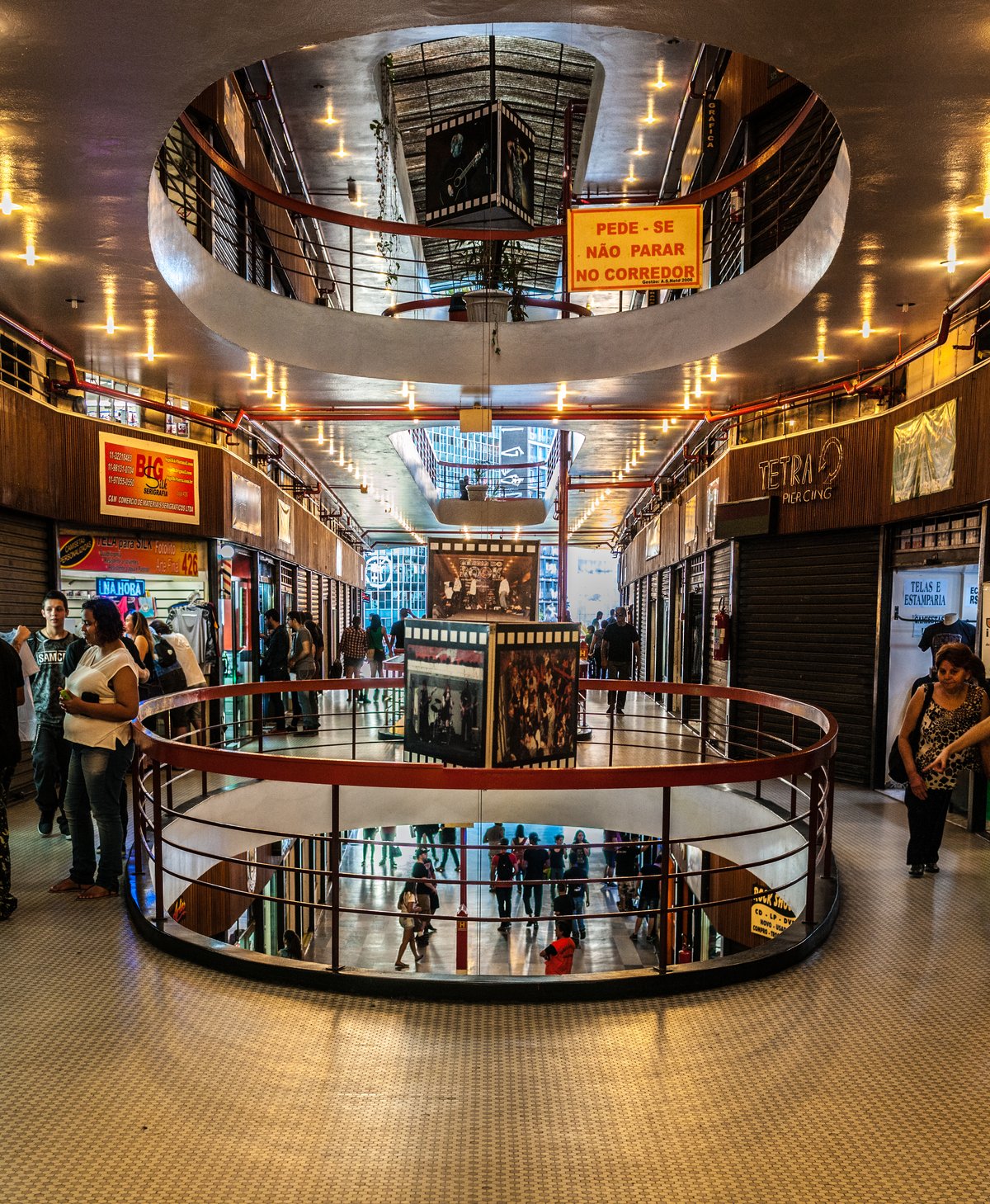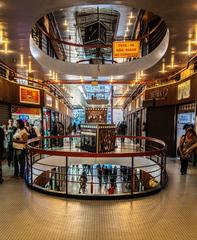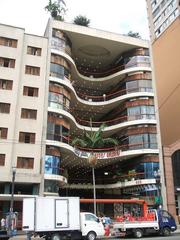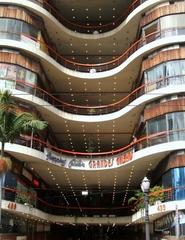
Galeria do Rock São Paulo: Visiting Hours, Tickets, and Visitor Guide
Date: 14/06/2025
Introduction
Galeria do Rock, officially known as Centro Comercial Grandes Galerias, is an essential destination in São Paulo for fans of music, alternative fashion, urban art, and cultural diversity. Since its opening in 1963, this landmark has transformed from a modernist commercial center into a vibrant hub where subcultures thrive, drawing tens of thousands of visitors each week. This guide covers everything from the Galeria’s history and architecture to practical information about visiting hours, accessibility, events, and nearby attractions. Whether you’re a music aficionado, architecture enthusiast, or first-time visitor, Galeria do Rock promises an unforgettable experience at the heart of São Paulo’s urban culture (Wikipedia; Portal São Francisco; Travel 2 Concert; Tourb).
Table of Contents
- Introduction
- Historical Background & Evolution
- Architectural Features & Urban Art
- Visiting Information
- Shopping, Services, and Events
- Nearby Attractions & Suggested Itineraries
- FAQs
- Conclusion & How to Stay Updated
- References
Historical Background & Evolution
Modernist Beginnings (1960s–1970s)
Galeria do Rock was conceived in the late 1950s amid efforts to revitalize downtown São Paulo. Designed by Siffredi & Bardelli—architects influenced by Oscar Niemeyer’s modernist vision—the building opened in 1963 as Centro Comercial Grandes Galerias. Its initial focus was on textiles, tailoring, and technical services, reflecting São Paulo’s commercial trends at the time (Wikipedia; ClickMuseus).
Cultural Transformation (Late 1970s–1990s)
By the late 1970s, as new shopping centers emerged elsewhere in São Paulo, many original tenants left, and the Galeria entered a period of decline. However, the arrival of record stores marked a pivotal shift, turning Galeria do Rock into a focal point for music culture—especially rock, punk, and alternative genres. The 1980s and 1990s saw the Galeria cement its identity as a gathering place for diverse urban tribes, from punks and skaters to hip-hop fans (Portal São Francisco; Wikipedia).
Revival and Recognition (1990s–Present)
Antonio de Souza Neto (“Toninho da Galeria”) led significant revitalization efforts in the 1990s, modernizing facilities and enhancing security. In 1992, Galeria do Rock was declared a site of cultural relevance by São Paulo’s heritage council, Conpresp, ensuring its preservation (Wikipedia). Today, it houses over 450 stores and is a vibrant venue for music, art, and fashion, welcoming up to 35,000 visitors on weekends (Gazeta SP).
Architectural Features & Urban Art
Modernist Design
Galeria do Rock’s architecture is a hallmark of Brazilian modernism, featuring undulating concrete facades inspired by Oscar Niemeyer. Its open atrium and panoramic staircases allow natural light to flood the interior, offering sweeping views across its five main floors (Portal São Francisco; Wikipedia).
Layout and Function
Each floor has a distinct character:
- Subsolo (Basement): Hip-hop, streetwear, sneaker shops, and urban fashion.
- Térreo (Ground Floor): Clothing, tattoo studios, snack bars.
- First & Second Floors: Record stores, band merchandise, fashion, hair salons, and ticket outlets.
- Third Floor: Tattoo supplies, clothing, and a tobacconist.
- Fourth Floor: Screen printing, custom apparel, and the official Sepultura fan club (Guia da Semana).
Urban Art
Galeria do Rock is famous for its murals and graffiti, with ever-changing art that celebrates São Paulo’s musical and urban culture. The rooftop, revitalized in recent years, hosts concerts and offers panoramic city views (Veja SP; Agenda Cultural São Paulo).
Visiting Information
Operating Hours & Tickets
- Hours: Monday–Saturday, 10:00 AM–8:00 PM (some shops open Sundays; check official Instagram for updates).
- Tickets: Entry is free. Some special concerts or rooftop events may require advance tickets (Tourb).
Location & Accessibility
- Address: Avenida São João, 439 – República, São Paulo.
- Public Transit: Near República and São Bento metro stations; accessible by many bus lines (Entre Mochilas e Malinhas; Tourb).
- Parking: Several lots nearby, with daily rates around R$25 as of 2024.
- Accessibility: Elevators, ramps, and accessible restrooms make the Galeria suitable for strollers and visitors with mobility needs. The rooftop is also wheelchair accessible (Agenda Cultural São Paulo).
Navigating the Galeria
- Five Levels: Each floor specializes in different cultural niches. Consult the site map or ask at the information desk for specific shop locations.
- Family-Friendly: The Galeria is welcoming to families, with many parents introducing children to the city’s musical and cultural history (Entre Mochilas e Malinhas).
Safety Tips
- Stay alert to personal belongings, especially during busy weekends.
- Avoid displaying valuables openly and use caution after dark.
- Increased police presence and revitalization efforts have improved safety, but standard urban vigilance is recommended (Entre Mochilas e Malinhas).
Shopping, Services, and Events
Diverse Shopping Experience
- Band Merchandise: Shops like Consulado do Rock and Stamp (with its Iron Maiden mascot) offer rare and vintage band t-shirts (Guia da Semana).
- Vinyl & CDs: Baratos Afins is a must-visit for collectors, offering rare records and knowledgeable staff.
- Tattoo & Piercing: Numerous studios operate under strict hygiene standards—avoid street vendors outside.
- Alternative Fashion: Punk, goth, skate and hip hop styles, plus costumes and esoteric items.
- Instruments & Repairs: Several shops cater to musicians.
- Snacks: Rainha do Paissandú, on the ground floor, is a local favorite for quick bites.
Events & Cultural Activities
- Live Shows: Regular concerts and DJ sets, especially on the rooftop, are a highlight. Saturday rooftop events run from 11:00 AM to 5:00 PM and are family-friendly (Agenda Cultural São Paulo).
- Art Exhibitions & Pop-Up Markets: Rotating art and photography shows, street art fairs, and indie markets occur throughout the year (Todos Pelo Centro).
- Sustainability: The rooftop’s organic garden reflects a commitment to community and sustainability (Todos Pelo Centro).
Nearby Attractions & Suggested Itineraries
Use Galeria do Rock as a launchpad for exploring São Paulo’s vibrant downtown:
- Farol Santander: Cultural hub with city views.
- Mosteiro de São Bento: Historic monastery renowned for Gregorian chants.
- Theatro Municipal: Iconic opera house with guided tours.
- Praça da República: Lively square just steps away.
- Pinacoteca do Estado: Premier art museum accessible by public transit.
Combining these sites with a visit to Galeria do Rock offers a comprehensive urban cultural experience (Entre Mochilas e Malinhas).
Frequently Asked Questions (FAQ)
Q: What are Galeria do Rock’s visiting hours?
A: Generally Monday to Saturday, 10:00 AM–8:00 PM. Some stores open Sundays; check Instagram for updates.
Q: Is there an entry fee?
A: No, entry is free. Special events may require tickets.
Q: How do I get there via public transport?
A: Use República or São Bento metro stations; numerous bus lines also serve the area.
Q: Is the Galeria accessible for people with disabilities?
A: Yes, with elevators, ramps, and accessible restrooms.
Q: Are guided tours available?
A: Guided tours are not regularly scheduled but may be offered during special events or through private operators.
Q: Is the Galeria family-friendly?
A: Yes, many areas and events are suitable for all ages, including children.
Conclusion & How to Stay Updated
Galeria do Rock stands as a vibrant testament to São Paulo’s musical legacy, architectural innovation, and urban diversity. Its blend of alternative fashion, music stores, live events, and urban art makes it a one-of-a-kind cultural hub. Plan your visit for a weekday to avoid crowds, and explore nearby landmarks for a richer experience. For real-time updates on hours, events, and exclusive offers, follow the official Instagram. Download the Audiala app for personalized tips and guides to São Paulo’s most exciting attractions.






































































































































































